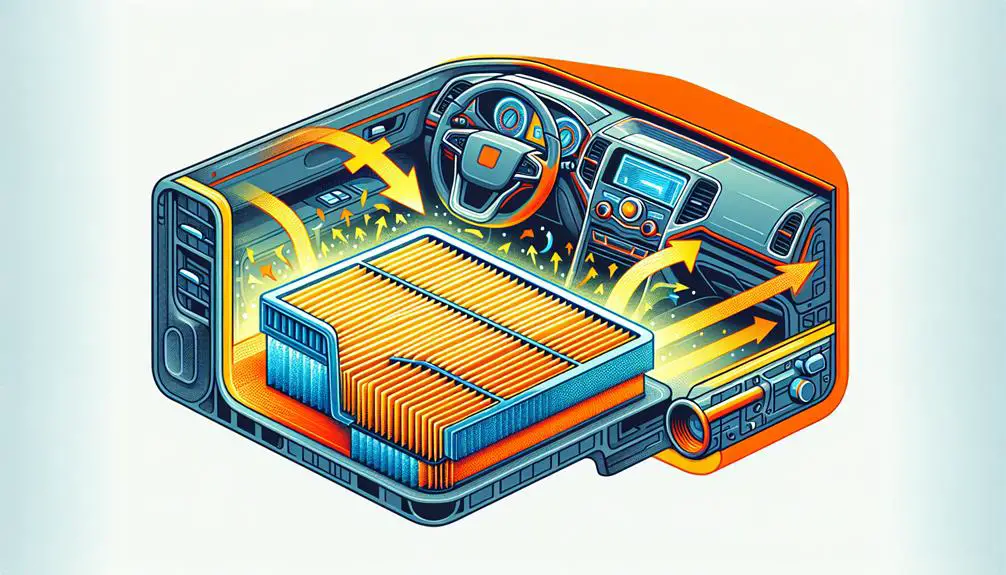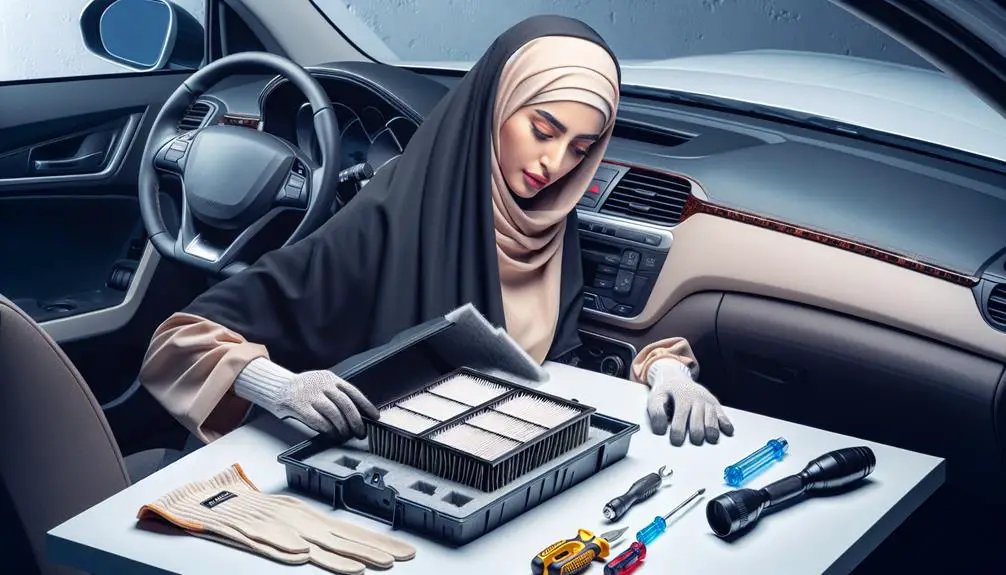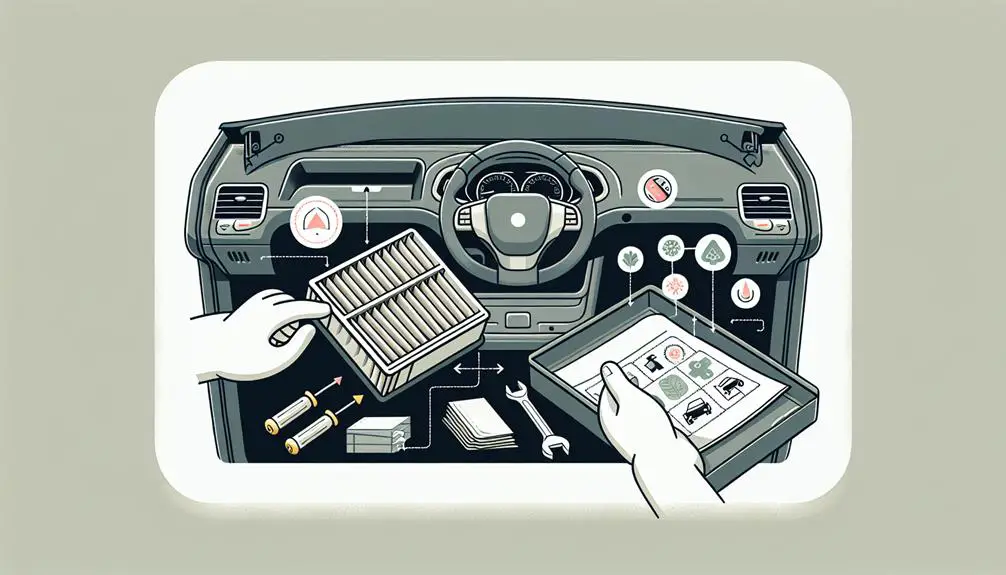Changing your Hyundai's cabin air filter involves a few simple steps. First, you need to locate the filter, which is usually found behind the glove box or under the dashboard. Once you have located the filter, you can remove the old one and replace it with a new filter. Finally, make sure to secure the filter in place and test your air conditioning system to ensure that it is working properly.
This routine maintenance task can help improve the air quality inside your vehicle by ensuring that clean air is circulated throughout the cabin. Regularly changing your cabin air filter can also help prevent dust, pollen, and other contaminants from entering your car's interior. By following these steps, you can easily maintain a healthy and comfortable environment inside your Hyundai.
Understanding Cabin Air Filters

Cabin air filters, essential for maintaining air quality inside your Hyundai, trap contaminants such as pollen, dust, and other airborne particles, ensuring a cleaner, healthier cabin environment. The benefits of a well-maintained cabin air filter extend beyond mere comfort. They play an essential role in safeguarding your respiratory health and overall well-being. By filtering out fine particulates and pollutants, these filters play a crucial role in reducing your exposure to harmful substances, mitigating health implications associated with poor air quality.
Regular replacement and maintenance of your cabin air filter are paramount. Over time, filters become saturated with particles, diminishing their effectiveness and potentially impairing airflow. This not only compromises the air quality inside your vehicle but can strain your Hyundai's HVAC system, leading to decreased efficiency and, possibly, premature wear.
Understanding the technical aspects of how cabin air filters function helps underscore their importance. These filters are typically made from a multi-fiber cotton or engineered material, which effectively captures contaminants while allowing air to flow freely. Essential performance is achieved through a balance of high filtration efficiency and airflow, ensuring your vehicle's interior remains a safe, comfortable space free from pollutants and allergens.
Locating Your Hyundai's Filter
To locate your Hyundai's cabin air filter, you'll need to consult your vehicle's owner's manual for the specific location, as it varies by model and year. The cabin air filter is typically situated behind the glove box or under the dashboard on the passenger side. In some models, it may be located in the engine compartment near the windshield. Identifying the exact position is vital for ensuring the replacement process is smooth and correct.
Comprehending filter compatibility is critical before purchasing a new cabin air filter. Hyundai models require specific filters to guarantee excellent air quality and system performance. Using an incompatible filter can result in inadequate filtration or even damage to the air conditioning system, impacting both comfort and safety.
Installation costs can vary significantly depending on if you choose to replace the cabin air filter yourself or seek professional assistance. DIY replacement can save on labor costs, but it's essential to be comfortable with your vehicle's mechanics. Professional installation, while more expensive, ensures that the filter fits perfectly and operates as intended, guaranteeing your Hyundai's air system remains efficient and effective.
Preparing for Replacement

Before you commence the replacement process, make sure you have the correct tools and replacement filter designed specifically for your Hyundai model. Preparing adequately will ensure a smooth and safe replacement procedure. Tool selection and adhering to safety measures are important steps in this preparation phase.
Here are the important steps you should follow:
- Tool Selection: Gather the necessary tools such as a screwdriver, pliers, and a flashlight. These tools will help you access and replace the cabin air filter efficiently.
- Safety Measures: Wear protective gloves and glasses to safeguard yourself against dust and debris. Ensuring your personal safety is important.
- Check the Filter Specifications: Verify the size and type of the replacement filter. Using the wrong filter can lead to ineffective filtration or even damage to your vehicle's HVAC system.
- Workspace Preparation: Clear the area around your vehicle to provide ample space for working. A clean, well-lit workspace is important for a smooth operation.
- Review the Manual: Quickly glance through your Hyundai's manual for any specific instructions or warnings related to the cabin air filter replacement. This can provide valuable insights and prevent any mishaps.
Executing the Filter Change
Now that you've prepared your workspace and gathered the necessary tools, let's proceed with replacing your Hyundai's cabin air filter. First, locate the cabin air filter housing, typically found behind the glove box or under the dashboard on the passenger's side. You'll need to carefully remove any covers or panels obstructing access, often secured with clips or screws.
Gently pull out the old filter, noting its orientation. This is important as the new filter must be installed in the same direction. Inspect the housing for any debris or dust and clean it with a soft cloth if necessary.
When selecting a replacement, consider reputable filter brands that guarantee compatibility with your Hyundai model. Each brand offers varying degrees of filtration, so choose according to your specific needs.
Insert the new filter carefully, ensuring it's properly seated and aligned. Replace any covers or panels you removed during the process.
Lastly, dispose of the old filter responsibly. Most filters are made of recyclable materials, so check local recycling guidelines. If recycling isn't an option, follow proper disposal methods to minimize environmental impact.
Maintenance and Tips

After installing your new cabin air filter, regularly checking and maintaining it guarantees top air quality and vehicle performance. Understanding the importance of your Hyundai's cabin air filter is crucial for ensuring a clean and healthy environment inside your car. Here are some maintenance tips and insights to help you maximize the filter lifespan and maintain top air quality:
- Inspect the Filter Regularly: Make it a habit to check your cabin air filter every 15,000 to 20,000 miles. This frequency can vary based on your driving conditions.
- Know When to Replace: If you notice persistent unpleasant odors, reduced airflow through the HVAC system, or an increase in noise when the system is running, it's likely time for a new filter.
- Avoid Cheap Alternatives: Opt for high-quality filters that specifically match your Hyundai model to ensure effective filtration and a proper fit.
- Clean the Filter Housing: Whenever you replace the filter, take a moment to clean the housing and the surrounding area to prevent dirt from entering the system.
- Monitor Air Quality: Pay attention to the air quality inside your car. A decrease in quality could indicate it's time to check the filter, even if you haven't reached the recommended mileage for a change.
Following these guidelines will help you keep your Hyundai's cabin air fresh and guarantee the longevity of your air filtration system.
Conclusion
You've now mastered changing your Hyundai's cabin air filter. Remember, it's located behind the glove box or under the dashboard, depending on your model. Always make sure you've got the right tools and replacement filter before starting.
Gently remove the old filter, noting its orientation, and slide the new one in place. Regular maintenance keeps the air in your cabin clean, enhancing your driving experience.
Stick to a yearly replacement schedule to make sure you have clean air quality and system performance.